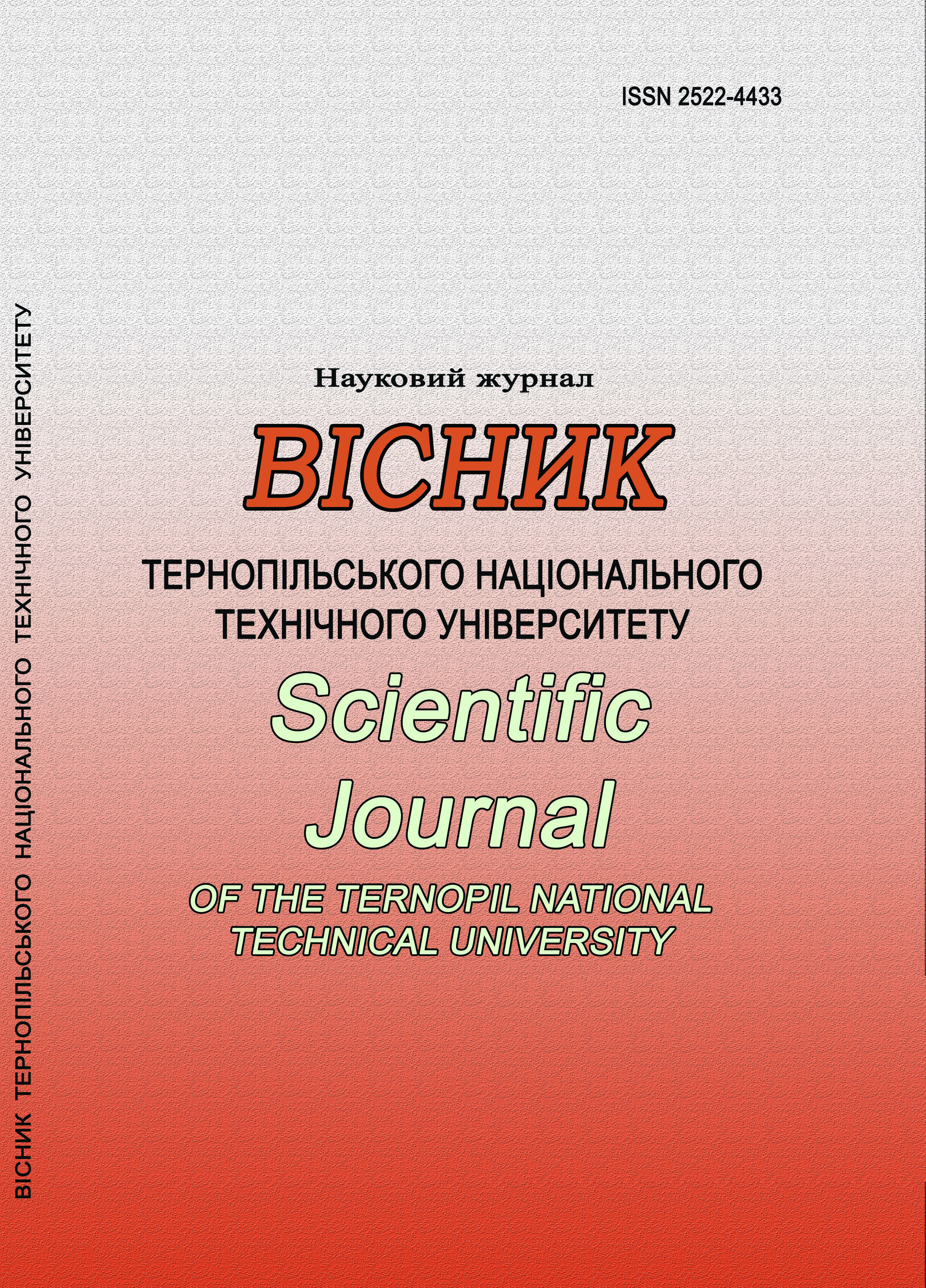Experimental studies of the width of the swath of tops of root crops
Main Article Content
Abstract
The search for effective technical solutions and scientific directions for substantiating the rational parameters of the working bodies of thick-cutting devices, which ensure an increase in the production of strategically important for the leading processing industries of Ukraine's economy (energy – biofuel; food – sugar, coffee; pharmaceutical – inulin) of technical crops or root crops is relevant and a significant direction of research, both for science and practice. The article presents the results of testing the adequacy of the developed analytical model, which functionally describes the process of unloading the cut root crop pulp onto the surface of the harvested field by the transport element (screw conveyor) of the pulp cutting module depending on the parameters of the screw conveyor. On the basis of the processing of the experimental data array, the regression equation of the change in the width of the formed swath of cut chaff was obtained depending on the input parameters: the speed of the chaff harvesting module, the chaff yield and the rotation frequency of the screw conveyor. It was established that within the range of variation of the input factors, the speed of movement of the module from 1.6 to 2.4 m/s, the yield of root crops from 120 to 180 t/ha and the rotation frequency of the screw conveyor from 40 to 100 rpm, the width of the formed roll of chopped the width of the swath is in the range from 0.5 to 1.4 m. The difference between the experimental and theoretical values of the width of the formed swath is within 5...10%. The obtained results of scientific research are a further step in the improvement of the methodology of optimizing the rational parameters of the working bodies of root-harvesting machines.
Article Details
Issue
Section

This work is licensed under a Creative Commons Attribution 4.0 International License.
References
1. Baranovskyi V. M., Berezhenko Ye. B., Pankiv M. R., Berezhenko B. M., Boiko V. A. Tekhnolohichni aspekty protsesiv roboty hychkozbyralnykh moduliv: monohrafiia. Ternopil: Redaktsiino-vydavnychyi viddil Ternopilskoho natsionalnoho tekhnichnoho universytetu imeni Ivaha Puliuia, 2022. 294 р. [In Ukrainian].
2. Boyko V. Mathematical model of the process of contact interaction of the copier with the head of the chicory root crop. Scientific Journal of the TNTU. 2023. Vol. 111. No. 3. P. 115–125. https://doi.org/10.33108/visnyk_tntu2023.03.115
3. Baranovskyi V., Herasymchuk H., Dubchak N., Berezhenko Ye., Boiko V. Eksperymentalni doslidzhennia ahrobiolohichnykh kharakterystyk koreneplodiv. Visnyk Lvivskoho natsionalnoho ahrarnoho universytetu: ahroinzhenerni doslidzhennia. 2020. No. 24. P. 13–21. [In Ukrainian]. https://doi.org/10.31734/agroengineering2020.24.013
4. Baranovskyi V. M., Pidhurskyi M. I., Pankiv M. R., Tesliuk V. V., Onyshchenko V. B. Osnovy rozrobky adaptovanykh transportno-tekhnolohichnykh system korenezbyralnykh mashyn: monohrafiia. Ternopil: TNTU im. I. Puliuia. 351 p. [In Ukrainian].
5. Hurchenko O. P., Baranovskyi V. M. Rezultaty vyprobuvannia modernizovanoi korenezbyralnoi mashyny MKK-6A. Mekhanizatsiia ta elektryfikatsiia silskoho hospodarstva. 1995. Vyp. 81. P. 57–60. [Іn Ukrainian].
6. Baranovskyi V. M. Transportno-tekhnolohichni systemy ochysnykh robochykh orhaniv adaptovanoi korenezbyralnoi mashyny. Silskohospodarski mashyny. 2013. P. 18–29. [in Ukrainian].
7. Ramsh V. Yu., Baranovskyi V. M., Pankiv M. R., Herasymchuk H. A.. Analiz tendentsii rozvytku robochykh orhaniv dlia separatsii vorokhu koreneplodiv. Naukovi notatky. 2011. No. 31. P. 298–305. [In Ukrainian].
8. Smal M. V., Herasymchuk O. O., Baranovskyi V. M. Matematychni modeli protsesu kopiiuvannia holovok koreneplodiv kopirom pasyvnoho doobrizchyka zalyshkiv hychky. Zbirnyk naukovykh prats Vinnytskoho natsionalnoho ahrarnoho universytetu. Seriia: Tekhnichni nauky. 2012. Tom 1. No. 11. P. 206–212. [In Ukrainian].
9. Voitiuk D. H., Baranovskyi V. M., Bulhakov V. M. ta in. Silskohospodarski mashyny. Osnovy teorii ta rozrakhunku: pidruchnyk / za red. D. H. Voitiuka. K.: Vyshcha osvita, 2005. 464 p. [In Ukrainian].
10. Baranovskyi V. M. Rezultaty teoretychno-eksperymentalnykh doslidzhen sekundnoi podachi vorokhu koreneplodiv. Mekhanizatsiia silskohospodarskoho vyrobnytstva. 2008. Tom 1. P. 111–118. [In Ukrainian].
11. Baranovsky V., Pankiv M., Kukhar O. et al. Results of the experimental investigations of fodder beets harvesting technologies. Scientific Journal of the Ternopil National Technical University. 2022. No. 2 (106). P. 16–26. https://doi.org/10.33108/visnyk_tntu2022.02.016
12. Boyko V., Baranovsky V., Pankiv V., Onyshchenko V., Marinenko S. The results of the study of the cutter of the remains of root crops haulm. Scientific Journal of the Ternopil National Technical University. 2023. No. 1 (109). P. 99–109. https://doi.org/10.33108/visnyk_tntu2023.01.099
13. Pankiv V. R., Tokarchuk O. A. Investigation of constructive geometrical and filling coefficients of combined grinding screw conveyor. INMATEH – Agricultural engineering. 2017. Vol. 51. No. 1. 2017. P. 59–68.
14. Hevko R. B., Yazlyuk B. O., Pankiv V. R. et al. Feasibility study of mixture transportation and stirring process in continuous-flow conveyors. INMATEH – Agricultural engineering. 2017. Vol. 51. No. 1. 2017. P. 49–58.
15. Baranovskyi V. M., Vyhovskyi A. Iu., Storozhuk I. M., Pankiv V. R. Rozrakhunok parametriv robochykh orhaniv hychkozbyralnykh mashyn: monohrafiia. K.: Komprynt, 2015. 242 p. [In Ukrainian].
16. Berezhenko E., Pankiv M., Jobbagy Jan, Berezhenko B. Experimental research of the module for gathering plant of chicory roots. Scientific Journal of TNTU. 2021. No. 1 (101). P. 56–67. https://doi.org/10.33108/visnyk_tntu2021.01.056
17. Baranovsky V., Potapenko M. Theoretical analysis of the technological feed of lifted root crops. INMATEH – Agricultural Engineering. 2017. Vol. 51. No. 1. 2017. P. 29–38.
18. Baranovsky V., Dubchak N., Pankiv M. Experimental research of stripping the leaves from root crops. Acta Technologica Agriculturae. 2017. Vol. 20. No. 3.P. 69–73. https://doi.org/10.1515/ata-2017-0014

